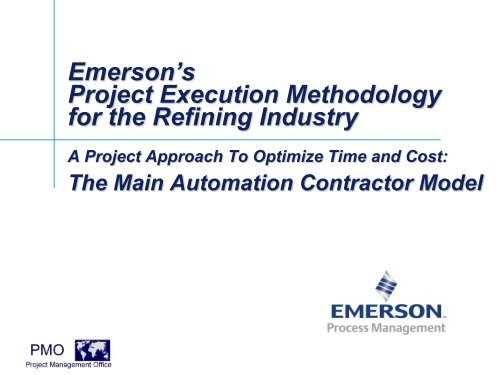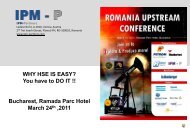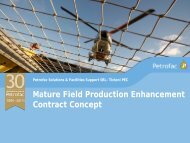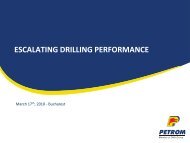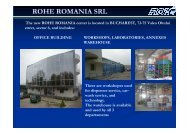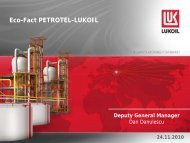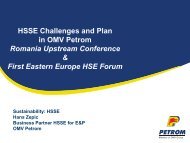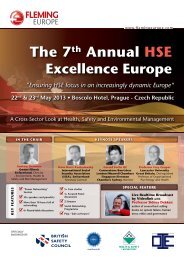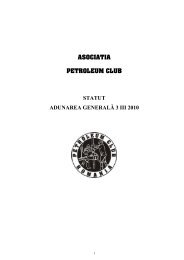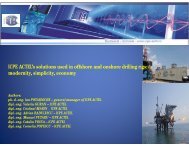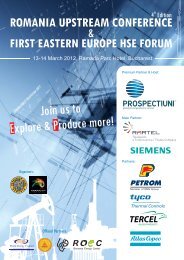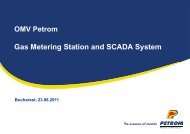A Project Approach To Optimize Time and Cost - Petroleumclub.ro
A Project Approach To Optimize Time and Cost - Petroleumclub.ro
A Project Approach To Optimize Time and Cost - Petroleumclub.ro
Create successful ePaper yourself
Turn your PDF publications into a flip-book with our unique Google optimized e-Paper software.
Emerson’s<st<strong>ro</strong>ng>P<strong>ro</strong>ject</st<strong>ro</strong>ng> Execution Methodologyfor the Refining IndustryA <st<strong>ro</strong>ng>P<strong>ro</strong>ject</st<strong>ro</strong>ng> <st<strong>ro</strong>ng>App<strong>ro</strong>ach</st<strong>ro</strong>ng> <st<strong>ro</strong>ng>To</st<strong>ro</strong>ng> <st<strong>ro</strong>ng>Optimize</st<strong>ro</strong>ng> <st<strong>ro</strong>ng>Time</st<strong>ro</strong>ng> <st<strong>ro</strong>ng>and</st<strong>ro</strong>ng> <st<strong>ro</strong>ng>Cost</st<strong>ro</strong>ng>:The Main Automation Contractor Model
Agenda1. The case for the Main Automation Contractor model2. The MAC <strong>ro</strong>le in the p<strong>ro</strong>ject lifecycle3. MAC Contracting options4. MAC model conclusionsSlide 2
Agenda1. The case for the Main AutomationContractor – MAC – modelSlide 3
Traditional P<strong>ro</strong>cess Automation <st<strong>ro</strong>ng>P<strong>ro</strong>ject</st<strong>ro</strong>ng>?Mostly LSTK Bidding MAC• Typically only 3 to 5% of a capital expenditure is p<strong>ro</strong>cess automation• It is usually bid late in the p<strong>ro</strong>ject after other infrastructure elements• It is bid piecemeal: Instruments, Valves, DCS, SIS, APC, PI, etc.Why Change F<strong>ro</strong>m Traditional LSTK to MAC?Although P<strong>ro</strong>cess Automation represents just 3 - 5% ofthe original capital expense, it is one of the mostimportant factors in successful plant operation.Slide 4
LSTK Model often leads to scope “creep”schedule delays <st<strong>ro</strong>ng>and</st<strong>ro</strong>ng> cost overruns• P<strong>ro</strong>cess Automation specs must be generalized inorder to allow multiple bidders.• Extra time spent in spec writing making sure basesare covered.• Bid evaluation time delays contractor engagement.• Without foreknowledge of winning bidders, it isimpossible to know if all vendors will integrateseamlessly. They rarely do!• Extras abound as contractors look for ways toincrease scope of work.• The end p<strong>ro</strong>duct is of necessity a comp<strong>ro</strong>mise.Slide 5
The Construction Industry InstituteRecognized The P<strong>ro</strong>blemCII studied the effect of earlyinvolvement of strategic suppliersThe recommendation was tomodify the current EPC model:PEpC app<strong>ro</strong>ach– P: P<strong>ro</strong>cure strategic suppliers first<st<strong>ro</strong>ng>and</st<strong>ro</strong>ng> early– E: Engineer (by contractorpartnered with strategic supplier)– p: P<strong>ro</strong>cure commodity items– C: ConstructIn Automation terms - MACSlide 6
Findings of the CII Study“Using a sophisticated simulation model of theclassic EPC p<strong>ro</strong>cess, the research teamcompared the impact of the PEpC app<strong>ro</strong>ach tothe p<strong>ro</strong>ject execution with traditional EPC.In both theoretical <st<strong>ro</strong>ng>and</st<strong>ro</strong>ng> field implementations,the results indicated that PEpC could p<strong>ro</strong>ducesavings in excess of 10% to 15% of the time<st<strong>ro</strong>ng>and</st<strong>ro</strong>ng> 4% to 8% percent of the cost of thetraditional EPC p<strong>ro</strong>cess”* Quote f<strong>ro</strong>m Edward M. Ruane, Head of CII Research Team, CII Research Summary 130-1; Page 5Slide 7
MAC Concept Definition• A highly qualified, large-p<strong>ro</strong>ject experienced, <st<strong>ro</strong>ng>and</st<strong>ro</strong>ng> wellresourced cont<strong>ro</strong>l systems specialist assigned tomanage, engineer, manufacture/p<strong>ro</strong>cure <st<strong>ro</strong>ng>and</st<strong>ro</strong>ng>deliver instrumentation, valves, cont<strong>ro</strong>l systems,safety systems <st<strong>ro</strong>ng>and</st<strong>ro</strong>ng> associated interfaces for allp<strong>ro</strong>ject components <st<strong>ro</strong>ng>and</st<strong>ro</strong>ng> facilities.• Assigned responsibilities are those the MAC is bestqualified to h<st<strong>ro</strong>ng>and</st<strong>ro</strong>ng>le.• Risk for the entire automation scope implementationis borne by the MAC.Slide 8
Motivation for MAC• Highly applicable to the downstream businesses.• Stewarding the execution of several grass-<strong>ro</strong>ots orrevamping p<strong>ro</strong>jects simultaneously.• Capitalizing on st<st<strong>ro</strong>ng>and</st<strong>ro</strong>ng>ardized p<strong>ro</strong>cesses, highly-skilledcore resources <st<strong>ro</strong>ng>and</st<strong>ro</strong>ng> increased concept re-usability.• Equally successful in p<strong>ro</strong>ject locations th<strong>ro</strong>ughout theworld with little or poor infra-structure.• Short p<strong>ro</strong>ject cycle time, high integrity of execution.• Early involvement in conceptual design <st<strong>ro</strong>ng>and</st<strong>ro</strong>ng> FEEDensures uniformity <st<strong>ro</strong>ng>and</st<strong>ro</strong>ng> consistency th<strong>ro</strong>ughout allp<strong>ro</strong>ject execution stages.Slide 9
The Main Automation Contractor ModelOld Way -Emerson supplied automation equipment & services to anEngineering, P<strong>ro</strong>curement <st<strong>ro</strong>ng>and</st<strong>ro</strong>ng> Construction ContractorConceptF<strong>ro</strong>nt EndEngineeringExecuteOperateNew Way -Emerson P<strong>ro</strong>duct Bid to EPCEmerson supplies Consulting, Engineering & Design <st<strong>ro</strong>ng>and</st<strong>ro</strong>ng>Supply of Automation Equipment <st<strong>ro</strong>ng>and</st<strong>ro</strong>ng> Services to EPC/OwnerConceptF<strong>ro</strong>nt EndEngineeringExecute OperateConsulting FEED EMR P<strong>ro</strong>duct ServicesNew <strong>ro</strong>le, Emerson partnering with EPC as Strategic Automation SupplierSlide 10
Agenda2. The MAC <strong>ro</strong>le in the <st<strong>ro</strong>ng>P<strong>ro</strong>ject</st<strong>ro</strong>ng>lifecycleSlide 11
The <st<strong>ro</strong>ng>P<strong>ro</strong>ject</st<strong>ro</strong>ng> LifecyclePhase 1APPRAISEPhase 2SELECTPhase 3DEFINEPhase 4EXECUTEPhase 5OPERATEIntegrate thediverseg<strong>ro</strong>ups ofideas <st<strong>ro</strong>ng>and</st<strong>ro</strong>ng>possibilitiesto evaluatethe p<strong>ro</strong>jectCONSULTINGCONCEPTSelect thepreferredp<strong>ro</strong>jectoption(s)Establish aPlantWebfoundationFEED PHASEFinalizep<strong>ro</strong>jectscope, cost,& schedule<st<strong>ro</strong>ng>and</st<strong>ro</strong>ng> awardcontracts.MAC SCOPEManagep<strong>ro</strong>ject withword classexcellenceOperatortrainingAssetOptimizationAdvancedcont<strong>ro</strong>limplementationThe MAC is critically important in 2 p<strong>ro</strong>ject phases1. F<strong>ro</strong>nt End Engineering Design2. <st<strong>ro</strong>ng>P<strong>ro</strong>ject</st<strong>ro</strong>ng> Execution
What is FEED ?FEED covers the basic & conceptual engineeringdone for the p<strong>ro</strong>ject prior to commencing the detailedp<strong>ro</strong>ject execution.Objective:• <st<strong>ro</strong>ng>To</st<strong>ro</strong>ng> p<strong>ro</strong>vide the detail engineering disciplines with welldefinedengineering packages in order to minimizechanges <st<strong>ro</strong>ng>and</st<strong>ro</strong>ng> rework during p<strong>ro</strong>ject execution.FEED offers the greatest opportunity for p<strong>ro</strong>jectdefinition, pre-planning <st<strong>ro</strong>ng>and</st<strong>ro</strong>ng> optimization, to lowerlifecycle cost <st<strong>ro</strong>ng>and</st<strong>ro</strong>ng> influence successful completion.Slide 13
Why is FEED critically important?The two main causes of cost overruns & schedule delays:• Poor definition of scope in FEED &• Loss of cont<strong>ro</strong>l of scope during p<strong>ro</strong>ject executionFEED <st<strong>ro</strong>ng>and</st<strong>ro</strong>ng> early p<strong>ro</strong>ject planning canreduce p<strong>ro</strong>ject cost with 20%Slide 14
Emerson’s app<strong>ro</strong>ach to FEED• FEED is the first opportunity to positively influencethe p<strong>ro</strong>ject success with the application of valueimp<strong>ro</strong>vement work p<strong>ro</strong>cesses.• Review/update customer engineering st<st<strong>ro</strong>ng>and</st<strong>ro</strong>ng>ards.• Define detailed field equipment, DCS <st<strong>ro</strong>ng>and</st<strong>ro</strong>ng> SISspecifications.• St<st<strong>ro</strong>ng>and</st<strong>ro</strong>ng>ardize systems interfaces <st<strong>ro</strong>ng>and</st<strong>ro</strong>ng> ensureconsistency ac<strong>ro</strong>ss all 3 rd party packages.• Coordinate engineering st<st<strong>ro</strong>ng>and</st<strong>ro</strong>ng>ardization ac<strong>ro</strong>ssmultiple p<strong>ro</strong>jects or contractors.• Define p<strong>ro</strong>ject execution strategy & schedule.Slide 15
Considerations during FEED• Clear p<strong>ro</strong>ject objectives• Scope definition & FEED deliverables• <st<strong>ro</strong>ng>P<strong>ro</strong>ject</st<strong>ro</strong>ng> execution plan• Budget estimate• FEED & detailed p<strong>ro</strong>ject execution schedules• <st<strong>ro</strong>ng>P<strong>ro</strong>ject</st<strong>ro</strong>ng> team organization• Lessons learned f<strong>ro</strong>m previous p<strong>ro</strong>jects• Life cycle cost optimizationSlide 16
<st<strong>ro</strong>ng>P<strong>ro</strong>ject</st<strong>ro</strong>ng> Execution - Engineering– Design Specifications for field instruments <st<strong>ro</strong>ng>and</st<strong>ro</strong>ng> valves, analytical, field packages(metering systems, tank management systems, BMS, gantry automation, etc).– Foundation Fieldbus basic segment design– Asset Management System Specification– Specification of Machinery Health Monitoring systems– Define major third party interfaces <st<strong>ro</strong>ng>and</st<strong>ro</strong>ng> common communications st<st<strong>ro</strong>ng>and</st<strong>ro</strong>ng>ard– DeltaV & DeltaV SIS System architecture– Create/update I/O database <st<strong>ro</strong>ng>and</st<strong>ro</strong>ng> data exchange mechanism (INtools)– FDS of Cont<strong>ro</strong>l Application / Safety Application– Specification of advanced cont<strong>ro</strong>l applications– Hardware specification <st<strong>ro</strong>ng>and</st<strong>ro</strong>ng> Cont<strong>ro</strong>l loop design– Generation of C&E diagrams <st<strong>ro</strong>ng>and</st<strong>ro</strong>ng> Cont<strong>ro</strong>l narratives– Issue system HW + SW testing <st<strong>ro</strong>ng>and</st<strong>ro</strong>ng> integrated testing specifications– Operator Training System SpecificationSlide 17
<st<strong>ro</strong>ng>P<strong>ro</strong>ject</st<strong>ro</strong>ng> Execution – <st<strong>ro</strong>ng>P<strong>ro</strong>ject</st<strong>ro</strong>ng> Management• Establish p<strong>ro</strong>ject execution strategy fully aligned with customer’s requirements.• Develop p<strong>ro</strong>ject schedule (engineering, p<strong>ro</strong>curement, construction,commissioning)• Develop budget.• Issue <st<strong>ro</strong>ng>P<strong>ro</strong>ject</st<strong>ro</strong>ng> Execution Plan <st<strong>ro</strong>ng>and</st<strong>ro</strong>ng> Quality Plan.• Define Design Freeze points, Change cont<strong>ro</strong>l <st<strong>ro</strong>ng>and</st<strong>ro</strong>ng> change management.• Plan transition f<strong>ro</strong>m FEED to next p<strong>ro</strong>ject phases.• Assign specialists to key positions, manage p<strong>ro</strong>ject team.• Plan strategic p<strong>ro</strong>curement. Leverage benefits of alliances <st<strong>ro</strong>ng>and</st<strong>ro</strong>ng> best costcentres.• Establish responsibilities matrix. Assume lead <strong>ro</strong>le in coordinating 3 rd parties.• Preliminary plan the site support organization.• Actively apply integrated p<strong>ro</strong>ject management to optimize p<strong>ro</strong>ject cost <st<strong>ro</strong>ng>and</st<strong>ro</strong>ng>schedule.Slide 18
<st<strong>ro</strong>ng>P<strong>ro</strong>ject</st<strong>ro</strong>ng> Execution <st<strong>ro</strong>ng>App<strong>ro</strong>ach</st<strong>ro</strong>ng>esTraditional <st<strong>ro</strong>ng>App<strong>ro</strong>ach</st<strong>ro</strong>ng> (characterized by multiple contractors/suppliers):Contractors• Multiple Engineering Contractors p<strong>ro</strong>vide all instrumentation <st<strong>ro</strong>ng>and</st<strong>ro</strong>ng> cont<strong>ro</strong>ls engineering. 2+Design practices, databases, <st<strong>ro</strong>ng>and</st<strong>ro</strong>ng> documentation vary by contractor.• Various cont<strong>ro</strong>l systems suppliers p<strong>ro</strong>vide vendor data to the EC's <st<strong>ro</strong>ng>and</st<strong>ro</strong>ng> equipment to 3+the installation contractors.• Cont<strong>ro</strong>l system integrator configures <st<strong>ro</strong>ng>and</st<strong>ro</strong>ng> p<strong>ro</strong>grams the main cont<strong>ro</strong>l systems. 1 - 2• Installation contractors install the field instruments <st<strong>ro</strong>ng>and</st<strong>ro</strong>ng> cont<strong>ro</strong>l systems. 1 - 2• Commissioning contractor commissions the instrument <st<strong>ro</strong>ng>and</st<strong>ro</strong>ng> cont<strong>ro</strong>l systems. Included• Various equipment suppliers p<strong>ro</strong>vide training <st<strong>ro</strong>ng>and</st<strong>ro</strong>ng> after-market support Nume<strong>ro</strong>usTOTAL 8+MAC <st<strong>ro</strong>ng>App<strong>ro</strong>ach</st<strong>ro</strong>ng> (characterized by a single point resource):• MAC p<strong>ro</strong>vides most instrument <st<strong>ro</strong>ng>and</st<strong>ro</strong>ng> cont<strong>ro</strong>l engineering 1• MAC supplies core instrumentation <st<strong>ro</strong>ng>and</st<strong>ro</strong>ng> cont<strong>ro</strong>ls systems <st<strong>ro</strong>ng>and</st<strong>ro</strong>ng> assists with theIncludedp<strong>ro</strong>curement of other instrumentation.• MAC integrates <st<strong>ro</strong>ng>and</st<strong>ro</strong>ng> p<strong>ro</strong>grams all cont<strong>ro</strong>l systems (except packaged systems) Included• MAC supervises the installation of the instrumentation <st<strong>ro</strong>ng>and</st<strong>ro</strong>ng> cont<strong>ro</strong>l systems. Included• MAC supports the commissioning of the instrument <st<strong>ro</strong>ng>and</st<strong>ro</strong>ng> cont<strong>ro</strong>l systems. Included• MAC p<strong>ro</strong>vides necessary training <st<strong>ro</strong>ng>and</st<strong>ro</strong>ng> training tools for the instrument <st<strong>ro</strong>ng>and</st<strong>ro</strong>ng> cont<strong>ro</strong>l Includedsystems <st<strong>ro</strong>ng>and</st<strong>ro</strong>ng> all after-market services.TOTAL 1Slide 19
MAC Savings Are ThreefoldLower <st<strong>ro</strong>ng>P<strong>ro</strong>ject</st<strong>ro</strong>ng> <st<strong>ro</strong>ng>Cost</st<strong>ro</strong>ng>sFaster / SeamlessStartup100Extras806040200TraditionalCapExEngr.TraditionalMACMACEarly Involvement• Engineering savings 8 – 10%• Capital savings 25%• Fewer extras 10%Operational Efficiency* Excerpt of Shell MAC analysisStart-Up <st<strong>ro</strong>ng>Time</st<strong>ro</strong>ng>Long term operationalsavings ~10%
Agenda3. MAC - Contracting OptionsSlide 21
MAC Contracting Options• MAC directly contracted by Owner, utilizing anoptimum combination of reimbursable <st<strong>ro</strong>ng>and</st<strong>ro</strong>ng> lumpsum compensations• MAC selected by Owner <st<strong>ro</strong>ng>and</st<strong>ro</strong>ng> sub-contracted bya single EPC for the entire p<strong>ro</strong>ject scope• MAC selected by Owner <st<strong>ro</strong>ng>and</st<strong>ro</strong>ng> sub-contractedseparately by each EPC ContractorSlide 22
MAC Directly Contracted by OwnerEPC-1Owner<st<strong>ro</strong>ng>P<strong>ro</strong>ject</st<strong>ro</strong>ng> ManagementContractorEPC-2EPC-3EPC-4MACMAC Manages:• ICSS design <st<strong>ro</strong>ng>and</st<strong>ro</strong>ng> implementation• Systems interface design• Third party systems interfacespecification• Consistency - hardware <st<strong>ro</strong>ng>and</st<strong>ro</strong>ng>software devicesEPC Relationship• Equivalent st<st<strong>ro</strong>ng>and</st<strong>ro</strong>ng>ing• Separate but equal contracts• Required interfacing• Deliverables as specified by Owner• Scope boundaries obeyedSlide 23
MAC Selected By Owner <st<strong>ro</strong>ng>and</st<strong>ro</strong>ng>sub-contracted by EPCEPC-1Owner<st<strong>ro</strong>ng>P<strong>ro</strong>ject</st<strong>ro</strong>ng> ManagementContractorEPC-2EPC-3MACEPC-4MAC Manages:• ICSS design <st<strong>ro</strong>ng>and</st<strong>ro</strong>ng> implementation• Systems interface design• Third party systems interfacespecification• Consistency - hardware <st<strong>ro</strong>ng>and</st<strong>ro</strong>ng>software devicesEPC Relationship:• MAC subservient to EPC• MAC scope varies by EPCinterpretation• Scope boundaries grayed• Consistency difficult to manageSlide 24
MAC Scope <st<strong>ro</strong>ng>and</st<strong>ro</strong>ng> Contract CompensationCompensationMAC ScopeTRAININGSTART-UPCONSTRUCTIONReimbursable Rates• Difficult to define total requirements <st<strong>ro</strong>ng>and</st<strong>ro</strong>ng>/or• Contractor not in cont<strong>ro</strong>l of schedule,sequence & highly dependent on othercontractor activitiesTrainingCommissioning &Startup SupportConstructionSupervisionDetailed Design& HardwareSupplyFEEDEngineeringDETAIL DESIGN&HARDWARESUPPLYLump Sum• P<strong>ro</strong>visional lump sum for major portion ofcontract• Contractors will bid on a “model” systemconfiguration as defined in ITT• “Model” app<strong>ro</strong>ach keeps all bidders on equal<st<strong>ro</strong>ng>and</st<strong>ro</strong>ng> competitive basis• “Model” will be adjusted to actual systemconfiguration at end of FEED; there will beadditions <st<strong>ro</strong>ng>and</st<strong>ro</strong>ng> deletions as technical definitionimp<strong>ro</strong>ves• Additions <st<strong>ro</strong>ng>and</st<strong>ro</strong>ng> deletions will be incorporatedinto lump sum based on firm-bid schedule ofrates <st<strong>ro</strong>ng>and</st<strong>ro</strong>ng> unit costsOperationsSupport(Lifecycle)FEEDReimbursable Rates• Difficult to define total requirements beforeFEED• MAC must work with multiple contractorswithout cont<strong>ro</strong>l over interfaces, responsetime, <st<strong>ro</strong>ng>and</st<strong>ro</strong>ng> changing requirementsSlide 25
MAC Contracting Measures• Steps Taken to Mitigate MAC Impacts to EPC ContractsUnder a Direct Contract:– Owner I&C Engineer assigned to manage the MAC/EPCinterfaces.– Detailed assignment of <strong>ro</strong>les <st<strong>ro</strong>ng>and</st<strong>ro</strong>ng> responsibilitiesestablished for the MAC <st<strong>ro</strong>ng>and</st<strong>ro</strong>ng> the EPC’s.– MAC personnel assigned to each EPC Team.– All field construction drawings are p<strong>ro</strong>duced by the EPC.– All field construction activities are assigned to the EPC’s.MAC only p<strong>ro</strong>vides assistance <st<strong>ro</strong>ng>and</st<strong>ro</strong>ng> support.– Commissioning <st<strong>ro</strong>ng>and</st<strong>ro</strong>ng> start-up are under EPC cont<strong>ro</strong>l.Slide 26
Agenda4. MAC model conclusionsSlide 27
MAC impact on Life Cycle <st<strong>ro</strong>ng>Cost</st<strong>ro</strong>ng>Life Cycle <st<strong>ro</strong>ng>Cost</st<strong>ro</strong>ng> = total cost f<strong>ro</strong>m inception to decommissioningLCC = acquisition cost + sustaining costFEEDDetail engineeringFacilities & equipmentConstruction & startupSupport facilitiesOperationsMaintenanceReplacementFacility usageEnergyWe focus on identifying cost drivers, evaluating alternatives,applying best practices <st<strong>ro</strong>ng>and</st<strong>ro</strong>ng> selecting the most efficient concept.We look beyond initial capital costs, take into account <st<strong>ro</strong>ng>and</st<strong>ro</strong>ng>optimize all components of operations <st<strong>ro</strong>ng>and</st<strong>ro</strong>ng> maintenance.Slide 28
Emerson focus on Life Cycle <st<strong>ro</strong>ng>Cost</st<strong>ro</strong>ng>Acquisition cost components:• <st<strong>ro</strong>ng>P<strong>ro</strong>ject</st<strong>ro</strong>ng> management <st<strong>ro</strong>ng>and</st<strong>ro</strong>ng> engineering• Equipment & Applications – instruments, valves,analytical, metering, tank gauging, FF, DCS, SIS,AMS, condition monitoring, OTS, APC, Guardian.• Construction <st<strong>ro</strong>ng>and</st<strong>ro</strong>ng> commissioning servicesSlide 29
Emerson focus on Life Cycle <st<strong>ro</strong>ng>Cost</st<strong>ro</strong>ng>Sustaining cost components:• Effectiveness: <strong>ro</strong>bust, reliable systems, applicationsengineered for optimized, agile p<strong>ro</strong>cess cont<strong>ro</strong>l.• Operations: highly intuitive <st<strong>ro</strong>ng>and</st<strong>ro</strong>ng> efficient systems<st<strong>ro</strong>ng>and</st<strong>ro</strong>ng> applications, integrated DCS & SIS, PlantWeb,embedded APC• Maintenance: intelligent field, FF, PlantWeb, AMSSlide 30
MAC Model Conclusions• Adoption of the MAC concept will result in:– Best available technology with lowest lifecycle costs.– Imp<strong>ro</strong>ved EPC performance & lower p<strong>ro</strong>ject costs.– Imp<strong>ro</strong>ved management of scope <st<strong>ro</strong>ng>and</st<strong>ro</strong>ng> schedule.– Lowest risk of scope expansion <st<strong>ro</strong>ng>and</st<strong>ro</strong>ng> resulting impacts.• The MAC concept has been:– P<strong>ro</strong>ven th<strong>ro</strong>ugh nume<strong>ro</strong>us completed p<strong>ro</strong>jects.– Developed as a service by Emerson.– Accepted by the EPC community to reduce overall risk.– Adopted by several customers as their st<st<strong>ro</strong>ng>and</st<strong>ro</strong>ng>ard practice.Slide 31
Slide 3232


